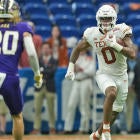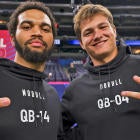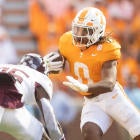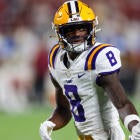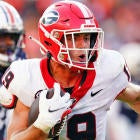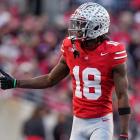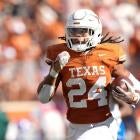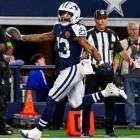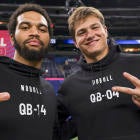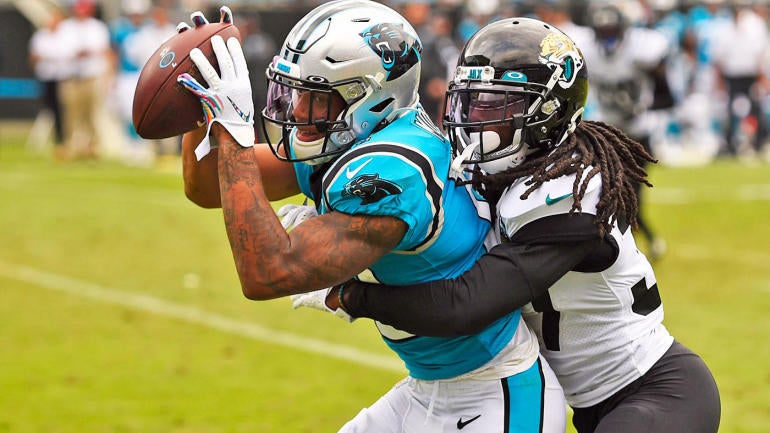
I've long struggled with how to accurately utilize projections when drafting my Fantasy football teams, because they are a snapshot of just one potential outcome for a player. That outcome might be the most likely one — that's what projections strive to articulate — but because it's a single possibility, a lot of context is lost.
I explained in my tight end range of outcomes article a little more about how this can mask fringe outcomes. I suggest giving the introduction to that piece a read for more information, but the gist is that these fringe outcomes, which are often lost in a projection of the most likely scenario, are the most important elements for Fantasy football. Peripheral outcomes are where league-winners are made, and league-winning upside outcomes have a disproportionate impact on who wins your league.
As we finish our position preview weeks here at CBS Fantasy, I'm finalizing my pieces emphasizing players at key decision points in drafts where the upside and downside outcomes should be weighed. We started with tight end, then hit then quarterback and running back positions, and today we'll look at the potential PPR outcomes for several wide receivers.
The charts you'll see are subjective -- they are inexact visuals I've created where I'm projecting not just the most likely outcome but a range. Many range of outcomes tools are built on player comps or other historical data, but I'm trying to be precise with what I think to be true for the specific players in question. That isn't easy, and your results will and should vary — maybe on my whole opinion of a player, or maybe just on the shape of their curve i.e. their projected range of upside or downside. We've also published tiered versions of my baseline wide receiver projections that you can review for context.
The way to read these curves is the probability under the curve at any given point is the probability of that outcome occurring. The higher the curve, the more likely I think that positional finish is in PPR scoring. Consider these charts mostly healthy projections, as they are an attempt to analyze the statistical production for each player.
D.J. Moore vs. Chris Godwin
For most other positions, I've been emphasizing how different types of players have different curves, but things are a little more generalized at WR. For instance, the top four wide receivers all have pretty fair Average Draft Positions with reasonably symmetrical upside and downside to what a typical projection would look like. That's the nature of high-end No. 1 wide receivers — we're confident in their target role, and things like team volume/success and touchdown rate dictate some of the annual fluctuation in their numbers.
Instead, the comparison I want to highlight at the top is two players I've seen as similar all offseason, but who don't have similar price tags. This is going to sound a bit like I'm down on Chris Godwin, so I want to first note I'm high on him long-term and think he's a clear hold in Dynasty formats. Although, while we're on that subject, one thing I find interesting is despite both of these players' youth, Godwin has been WR5 in Dynasty startups this offseason while D.J. Moore has been WR6, which is to say Moore gets the Dynasty bump a young, ascending star should relative to his WR11 re-draft ADP, while Godwin's value doesn't change much.
I would argue that's not a clear indication Godwin is overvalued, but it might be an indication Moore is undervalued. In Godwin's case, I think he's skated by a bit without enough discussion of potential efficiency regression. If we adjust for the depth of his targets, Godwin's yards per target or RACR (an air yards-based efficiency metric) were both wildly above average, approaching A.J. Brown territory, and Brown's impending regression has been the talk of the Fantasy community all offseason.
Godwin was also an incredibly efficient touchdown scorer with a TD rate of 7.4%, and while he finished as a top-five receiver in just 14 games as a 23-year-old — an objectively good thing — he also became the first top-five PPR receiver to fail to hit 130 targets since Jordy Nelson in 2011. Again, I think Godwin is poised to go on to a great career, but considering a quarterback change and the addition of Rob Gronkowski — whose target depth overlaps with Godwin's more than Mike Evans' — there's at least some concern Godwin's targets won't take a substantial step forward, in which case any loss in efficiency would likely leave him in the low-end WR1 or WR2 range. For as much as we know Tom Brady loves his slot receivers, he's also not had a player like Evans on the outside in quite some time, and at any rate Chris Towers makes a compelling case in the August 12 FFT Newsletter that the Bucs whole offense might have a little more downside than we recognize given Brady's age.
Then there's Moore, who was a better age-adjusted producer in college than Godwin and got selected in the first round of the NFL Draft (Godwin's slip to the third round looked silly at the time and looks sillier in hindsight). Moore also produced earlier in his pro career, falling just shy of 1,000 total yards as a 21-year-old rookie, while Godwin had to wait a bit to see the field significantly. Again, that looks like a mistake, and I'm not holding these things against Godwin at this point of his career as much as using them to emphasize Moore's unimpeachable profile to this point.
Last year was Moore's second season at 22 versus Godwin's third at 23, and Moore caught as many balls through 14 games (before a calf injury six snaps into his Week 16 game ended his season) as Godwin did in his 14 games. Moore did that on 12 more targets for about 150 fewer yards and five fewer touchdowns, and on the surface, Moore being worse on more targets isn't something to be argued as a good thing. But when we control for his younger age and recognize that Moore was still very efficient — and likely more sustainably so — especially considering his situation with Kyle Allen at quarterback, it's very hard to understand the re-draft ADP gap between these two ascending stars.
The way I see it for 2020, Godwin still has that touchdown edge, both because of his offense and because it might be fair to wonder whether Moore will ever be a big touchdown producer. And I have Godwin seeing an uptick in targets and having more absolute upside as a result. But that doesn't mean Godwin couldn't have his own low touchdown season, if red zone looks swing toward Evans and Gronkowski in 2020. And even while Moore is at risk of losing some target share should the new coaching staff shuffle things around — Curtis Samuel playing closer to the line of scrimmage, as rumored, could have an effect, as could a reduction in overall passing volume — I tend to feel more confident in Moore's target floor than Godwin's. I think Moore has a better shot to finish as a top-12 receiver and a higher floor overall, as the slight differences in the nearly identical curves above indicate. And while I'll still take Godwin when he falls, I'm much more excited about getting the similar player in Moore a round-plus later. In fact, I have Moore ranked one spot higher outright.
Low-volume offenses
Note that the scale has changed such that it now stretches to WR36.
I've written extensively about A.J. Brown, but I'm using him here as a proxy for a group of players that includes Tyler Lockett, Stefon Diggs, Terry McLaurin and Marquise Brown. All are players who, to varying degrees of certainty, I feel confident about their abilities. And all are players who don't look great by typical projections, simply because their offenses figure to be in the bottom half of the league in pass attempts.
But I want to talk about their perceived downside. In 2019, Kenny Golladay and Amari Cooper were both top-10 PPR receivers on fewer than 120 targets. Tyler Lockett was WR13, D.J. Chark was WR18, and Diggs, A.J. Brown and John Brown were all low-end WR2s — each of them, also, saw fewer than 120 targets, and Diggs and Brown didn't even see 100.
There are several points I'm trying to make here. First, far more receivers will project for 120 targets than will actually reach that mark in any given year. Second, wide receiver is a high variance position, and it's defined by efficiency spikes that don't show up in projections that are, by necessity, cautious on efficiency and largely driven by projectable opportunity.
And finally, one overarching theme of this entire series — quantifying the low-percentage upside outcomes matters. If you're just looking to beat ADP, you'll likely avoid potentially elite football players because they don't project to see enough targets to be elite Fantasy options. That's fine, but it's a safe way to approach your wide receiver position.
I would argue upside relative to draft value is most frequently found in players who don't project for strong opportunity for any number of reasons. This keeps their Draft Day price down, because they simply don't project to beat even a depressed ADP in their most likely scenario. Maybe they are blocked on the depth chart, in the case of a J.K. Dobbins or a Mecole Hardman. Maybe their offense doesn't project to be high volume, though we know projecting offenses is challenging.
But if you've been following along, you might be able to guess my next point — rather than distinctly avoiding this class of player, you should go out of your way to target them. I talked about why high-variance wide receivers are misunderstood earlier this week, but I feel strongly, as I showed in this graph, that players like A.J. Brown don't have substantially lower floors than players like Robert Woods. These players project to be either small misses relative to your Draft Day cost or big hits. In the above linked piece, I talked about how Brown's range and how he could see the necessary targets, but Diggs could get there if the first-round pick plus multiple more picks the Bills traded to acquire him indicates they see him as a true alpha at all depths of the field (unlike how the Vikings used him the past two years), and McLaurin or Brown could make huge Year 2 leaps if there offenses add play volume.
I don't even dislike Woods, and largely agree with the several hundred Fantasy articles written this offseason that he is a value, which I've tried to show in this curve. But we have a fairly long track record on him, and while I'm still giving him a reasonable shot to have an efficiency boom and finish as a top-10 receiver, he's likely to come in as a slight win relative to ADP. That's still worth targeting, and it's one reason why I love reasons in this draft range — whether you're chasing upside or stability, there are so many good options.
But for as much as I understand any projection system coming out higher on Woods in a most likely scenario than Brown, that is just shifting the shape of the curve, and No. 1 receivers still will have strong floors even in low-volume offenses. If they are truly elite talents, they will also have ceilings. Give me the player that is perhaps likely to finish only a few spots lower at the end of the season in a median outcome, but has the upside to be the next superstar.
Stability vs. upside in the later rounds
Speaking of Hardman, and speaking of quantifying upside, if you take a player like Jamison Crowder over a player like Mecole Hardman as a bench receiver, we probably will just never be friends.
Hardman has plenty of risk if the Chiefs use him as something of a straight backup to Tyreek Hill as they did in 2019, but he was a 21-year-old rookie last season and he acquitted himself phenomenally. If his role does expand starting in Week 1, you already have a monster Draft Day value. Opportunity of course could still come later in the year, because as I continue to harp on, NFL seasons are chaotic — and 2020 figures to be more so than any year ever — which means Hardman could frankly finish anywhere depending how high his opportunity climbs in such an explosive offense.
Crowder is fine, and he projects for plenty of targets and will probably beat ADP, as I've shown here. His WR26 PPR finish on 122 targets last year is a great example of the above point that No. 1 receivers in bad situations don't have extremely low floors. Of course, Crowder doesn't have any of the upside of guys like A.J. Brown, Marquise Brown, Diggs or McLaurin. His low aDOT, skill set and track record mean he's not likely to have a major efficiency spike any time soon.
Julian Edelman, at his age and with his injury history, and Marvin Jones are two more players I don't think have the upside to justify a pick where they go. They are not selections I make frequently. Will Fuller, Christian Kirk, Darius Slayton and several other youngsters I've written about elsewhere do possess the upside I'm looking for. Bonus points for those who have downfield target profiles that can help them to the spike efficiency typically necessary to have a big season on lower volume like several of the names I highlighted above did in 2019.
If you take one thing from this series, let it be this: Fantasy leagues are not won by accumulating small wins versus ADP; they are won through understanding we don't know as much in the preseason as we think we do, we need to quantify upside to benefit when the chaos of an NFL season hits, and those upside hits are what decides who takes home the crown. You of course can't draft an entire team full of low-probability bets, and guys like Hardman who have low floors are not always ideal targets. But sprinkling in more uncertainty and targeting more upside throughout your drafts is not just fun, it's smart.
So what Fantasy football sleepers should you snatch in your draft? And which WR1 candidate can you wait on until late? Visit SportsLine now to get cheat sheets from the model that was all over Derrick Henry's huge season, and find out.














